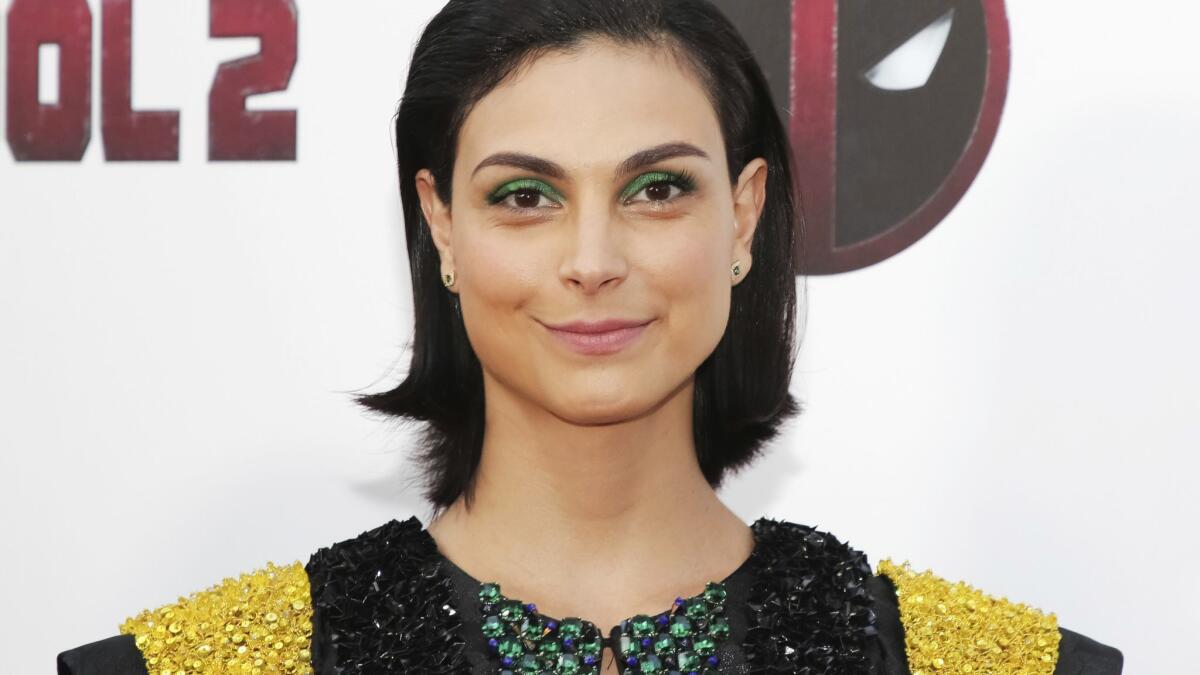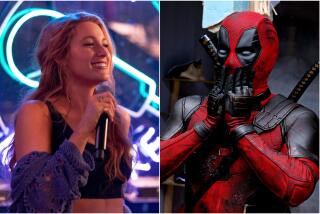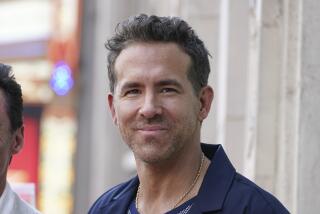‘Deadpool 2’ creative team breaks down three of the film’s biggest secrets and surprises
Warning: This story contains major plot spoilers about “Deadpool 2.”
From the very beginning, the creative team behind the “Deadpool” franchise has stuck to one very simple rule that guides every decision they make: “We always say, ‘If you can’t do it in another superhero movie, you’d best be doing it in a Deadpool movie,” said screenwriter Paul Wernick.
If this weekend’s massive $125-million box-office haul for “Deadpool 2” is any indication — the second-highest ever for an R-rated title, behind only its predecessor — it seems audiences agree.
Heading into the sequel to the original 2016 smash, the core returning team of screenwriters Wernick, Rhett Reese and star and co-writer Ryan Reynolds — who plays the foul-mouthed, fourth-wall-breaking antihero — knew that they couldn’t get away with just replicating the same blend of irreverence, ultraviolence and demented and raunchy R-rated comedy. Given the sky-high expectations this time around, Reese says, “There were definite trepidations.”
They needed, if possible, to kick things up a notch. Or maybe three.
How exactly to accomplish that, though, was hardly obvious. Through an arduous process of development — first with original “Deadpool” helmer Tim Miller and then, after he left the project due to creative differences, director David Leitch (“John Wick”) — the film’s storyline went through various radically different iterations.
“We always knew the tone and the texture of the movie, but we took lots of different twists and turns in terms of story,” said Wernick. “I bet we had three full scripts that we took bits and pieces of to make this last final script that everybody saw.”
In the end, as Wernick, Reese and Leitch explained to The Times, that final script came to rest on three key plot surprises that were carefully held back in the run-up to the film’s release — each of which smashed a different convention of the superhero genre.
(Final warning: If you haven’t seen “Deadpool 2” yet, stop reading here.)
1. Dispensing with the traditional villain.
When tackling any superhero sequel, the first question is generally, “What baddie will our hero be fighting this time?” Heading into the release of “Deadpool 2,” 20th Century Fox’s marketing campaign suggested that Deadpool’s main adversary would be Josh Brolin’s time-traveling cyborg soldier Cable, whose appearance was teased in the first film’s post-credits coda.
In reality, in early drafts of the sequel’s script, the “Deadpool” team were playing with the idea of setting Deadpool against various potential adversaries, including two well-established Marvel Comics supervillains, Mister X and Black Tom Cassidy (the latter of whom makes a more minimal and fairly inglorious appearance in “Deadpool 2”).
In the end, though, it was determined that Deadpool’s relationship with a troubled young mutant named Russell/Firefist (Julian Dennison) would form a more compelling emotional spine than a typical save-the-world narrative involving one all-powerful nemesis.
REVIEW: Snark conquers all in ‘Deadpool 2,’ a superhero sequel that’s more of the same »
“We decided we had enough people with differing motives butting heads that we didn’t really need a traditional mustache-twirling villain,” says Reese. “We had the evil headmaster, we had Juggernaut, we had Firefist himself as an adult in the future, we had Cable — and sometimes Deadpool is his own worst enemy in some ways. So we thought, ‘Why feel trapped into the trope of a villain who wants to conquer the world? Why not just have the particular goals of these characters come into conflict?’ ”
“As a filmmaker, I loved the challenge of not having a conventional villain,” Leitch said. “As you start to peel the onion back, you realize the real villain is all of us because we’re not showing [Russell] the compassion that he needs. That’s the big idea in a movie full of crazy action and fart jokes, but it felt right and earnest. The first film was a love story and this movie needed a real genuine emotional hook.”
2. Murdering the love interest early.

In many, if not most, superhero movies, it would be considered beyond the pale to kill off the protagonist’s love interest, let alone to do so in the film’s opening moments. But again, “Deadpool” is not most superhero movies.
The “Deadpool 2” team wanted to ramp up the film’s emotional stakes as high as possible right off the bat. So, just minutes into the film, after revealing that she is pregnant, Deadpool/Wade Wilson’s fiancée, Vanessa (Morena Baccarin), is shot and killed in the couple’s apartment — a tragedy that first puts him into a suicidal tailspin and then sends him on a journey to find a different kind of family.
If Vanessa’s death seemed extreme, that was the point. “At one point we had the two of them breaking up versus her dying,” Wernick said. “But Ryan always says Deadpool works best when you take away everything from him at the very beginning.”
“I think it’s part of the Deadpool universe that you need to go a little hardboiled,” said Leitch, who placed Keanu Reeves’ assassin John Wick in a similarly desperate hole at the beginning of that cult 2014 action hit, which he co-directed with Chad Stahelski.
“I think it would have been hard to do it with just that Vanessa got wounded or she just broke up with him. When we take her away, you can have this moment of empathy for him. As big of a loudmouth as he is, it really allows you to access, ‘Holy …, that was pretty dramatic.’ ”
(Of course, as anyone who stuck around for the post-credits sequence knows, in the end Deadpool uses a time-travel device to go back and prevent Vanessa’s death. So no harm, no foul.)
3. Immediately killing off a bunch of seemingly major new characters.
In another instance of subverting the genre, “Deadpool 2” wreaks playful havoc on a familiar comic-book-movie trope: the assembling of a team of heroes.
Midway through the film, Deadpool recruits a group of superheroes with mutant powers, including Domino (Zazie Beetz), Bedlam (Terry Crews), Shatterstar (Lewis Tan), Zeitgeist (Bill Skarsgard) and Vanisher (a blink-and-you-missed-it Brad Pitt) — plus one decidedly non-superpowered corporate shmoe from payroll named Peter (Rob Delaney). He grandly dubs the new team X-Force.
Then, just minutes into their big mission, all of them are unceremoniously killed — except for Domino, whose superpower just happens to be incredible luck.
‘Deadpool 2’ tops ‘Avengers’ but fails to surpass its predecessor »
“We just thought that would be so funny and so unexpected,” said Wernick. “Part of marketing’s job was to mislead the audience that this was X-Force, that all these guys were going to move forward in the franchise. Our job is to always keep the audience on the edge of the seat and not know what’s going to happen next.” (A separate X-Force project is in the works at Fox, with Drew Goddard set to direct.)
At one point during the film’s development, the question was raised whether it was worth investing such a significant amount of money and screen time in what is essentially a giant prank on the audience.
“When you’re getting into budget negotiations, they’re like, ‘What can you cut from the script?’ ” Leitch said. “I’m like, ‘Honestly, you could completely lift out this joke that lasts about 12 minutes and basically doesn’t move the narrative forward. But if you want it, you should pay for it, because it’s going to be amazing.’ ”
Like everything else, Leitch said, “It was a risk. What if the fans get invested? What if they like these new characters — and then we just flip them the bird and kill them all? But at the end of the day, the audience wants that from ‘Deadpool.’ They want to be teased and led on and messed with.”
Twitter: @joshrottenberg
More to Read
Only good movies
Get the Indie Focus newsletter, Mark Olsen's weekly guide to the world of cinema.
You may occasionally receive promotional content from the Los Angeles Times.











